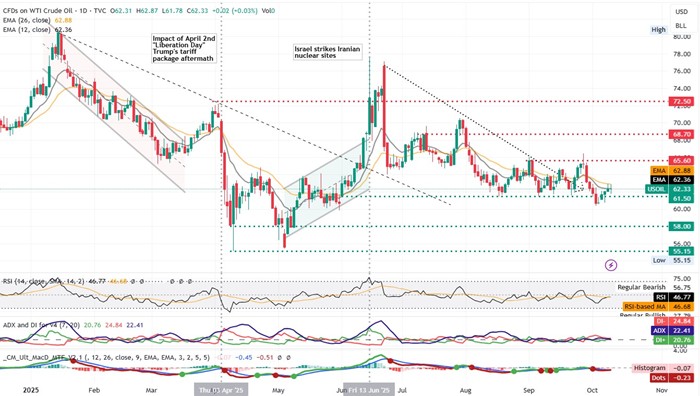- Geopolitical tensions across the Middle East softened this week as Israel and Hamas reportedly agreed to President Trump’s 20-point peace plan, reducing the odds of a flare up of crude prices should the ceasefire period be respected.
- The two parties have now entered the first phase of the plan, where prisoners of war will be mutually exchanged, Hamas will lay down arms and Israel cease operations and control in the war-torn Gaza strip.
- The oil cartel OPEC+ confirmed forecasts for an output hike in the month of November, albeit the rise being smaller-than-expected, extending its plans of pumping and shipping more crude in international markets and Russia’s exports remain near a 16-month peak, despite the ongoing war in Ukraine, which resulted in multiple refining disruptions.
- Crude futures nevertheless float near 4-month lows post the announcement and are facing further downward pressure as the latest stockpile data from the US indicated a larger than expected rise in both API and EIA, validating views for the prolongment of weak demand as we move further away from the peak summer period.
- Overall, weak demand fundamentals and expectations for an oversupplied market through 2026, could and are limiting upside momentum in the key energy commodity for the time being.
Technical Analysis of Oil
I Chart – Crude futures in “equilibrium mode” as momentum thins out

- Resistance: 65.60 (R1), 68.70 (R2), 72.50 (R3)
- Support: 61.50 (S1), 58.00 (S2), 55.15 (S3)
Crude futures are currently fluctuating near the $61.50 (S1) support base, a 4-month low, as bearish sentiment got countered by the return of the bulls, which contained the fall below the $60 mark. Given the lack of substantial fundamental catalysts, we maintain our bias for the prolongment of the sideways scenario for the time being, up until the point where a decisive move occurs. The RSI reading, the MACD and ADX indicators below the chart, all confirm the lack of volatility, momentum and strength from either bulls or bears, signalling that crude prices are in equilibrium mode.
In the scenario where, the bulls awaken and safeguard WTI’s price from crossing decisively below the $61.50 (S1) support base, then a move towards the $65.60 (R1) resistance barrier may be expected. On the contrary, should the bears unite their power and definitively drag WTI below the $61.50 (S1) support base, then an extension of the move towards the $58.00 (S2) support level shall be reasonably expected.
